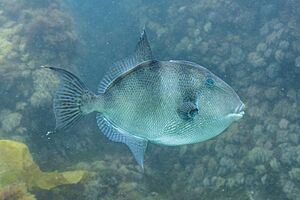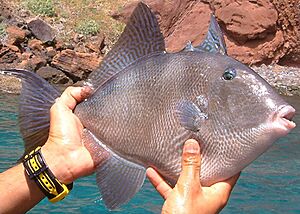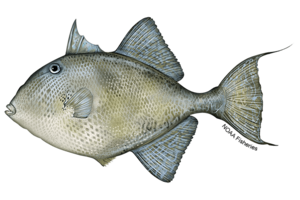Grey triggerfish facts for kids
Quick facts for kids Grey triggerfish |
|
|---|---|
 |
|
| Conservation status | |
| Scientific classification | |
| Synonyms | |
|
List
|
The grey triggerfish (Balistes capriscus) is a type of ray-finned fish. It belongs to the triggerfish family. This fish lives in shallow waters. You can find it in the western Atlantic Ocean, from Nova Scotia to Argentina. It also lives in the eastern Atlantic, the Mediterranean Sea, and off the coast of Angola.
The grey triggerfish looks and acts like other Balistes fish. However, it has a plain grey color. It is a fairly small fish, usually weighing less than 2.3 kg (5.1 lb). People enjoy fishing for it. Even though its skin is tough, it is a great fish to eat. Experts have listed the grey triggerfish as 'vulnerable'. This means its population is at risk.
Contents
About the Grey Triggerfish: Appearance and Features
The grey triggerfish is a medium-sized fish. It can grow up to 60 cm (24 in) long. However, it is more often about 44 cm (17 in) in length. Its mouth looks like a small beak. It has soft, fleshy lips. The eyes are set far back on its head.
This fish has a body that is flat from side to side. It is also quite deep. Its skin is tough and feels like leather. The first dorsal fin has three strong spines. The first spine is much longer than the others. The second dorsal fin has 26 to 29 soft rays. It looks similar to the anal fin below it. The anal fin has no spines and 23 to 26 soft rays. The pectoral fins are small and round. In older fish, the outer rays of the tail fin become longer. The scales on its head and front body are large. The scales on its back half are smaller and smooth.
The grey triggerfish is mostly pale grey, greenish-grey, or yellowish-brown. It has three faint dark stripes on its body. There is also a light streak on its chin. The top part of its eye is blue. You might see small blue spots and lines on its dorsal fins and upper body. Sometimes, it has white dots and lines on its lower body. Both the second dorsal and anal fins can look a bit marbled. As the fish gets older, its colors fade a little. Young triggerfish are usually more colorful.
Where Grey Triggerfish Live: Distribution and Habitat
The grey triggerfish mostly lives in shallow waters. It is found in the western Atlantic Ocean. Its home range goes from Nova Scotia down to the Caribbean Sea. It also lives in the Gulf of Mexico and near Bermuda. You can find it as far south as Argentina.
This fish usually lives over hard surfaces. These include reefs and rocky areas. It also likes lagoons and bays. It can be found at depths of up to 55 m (180 ft). The grey triggerfish also lives on the other side of the Atlantic. It is found around the British Isles, in the Mediterranean Sea, and off Angola. It might have crossed the Atlantic by riding the Gulf Stream currents. It now breeds in the Mediterranean.
In the past, this fish was rare in northern European seas. But now, more grey triggerfish are seen around the coast of Cornwall. This suggests they might be breeding there. They have also been found in other parts of Great Britain. This means their range is growing northwards. One was even caught as far north as the island of Tiree in Scotland.
How Grey Triggerfish Behave: Movement and Feeding
The grey triggerfish moves by waving its dorsal fins. If it feels in danger, it can hide in a small crack. It then uses its front dorsal spine to wedge itself in place. This makes it very hard to pull out. The second spine is linked to the first. When the second spine is pushed down, it unlocks the first one.
This fish lives near the seabed. It eats small animals that live on the bottom. These include shrimps, crabs, molluscs, sea urchins, sand dollars, starfish, and sea cucumbers. It has strong teeth. These teeth are perfect for breaking open hard shells.
An interesting way it feeds has been seen. The fish positions itself straight up over a sandy seabed. Then, it blows a stream of water out of its mouth. This stirs up the sand. It might uncover something tasty. More puffs of water expose more food. The fish then grabs the food with its sharp teeth. If it's a sand dollar, the fish drops it and picks it up many times. It does this until the sand dollar lands upside down. Then, the fish goes vertical again. It attacks the middle with its jaws closed. This crushes the soft center. Finally, it scoops out and eats the soft parts.
Grey Triggerfish Life Cycle and Reproduction
During the summer, when the water gets warm (around 21 °C (70 °F)), the grey triggerfish start to breed. Males turn a dark grey color. They become very protective of their area. Males dig up to a dozen nests in hollows in the sandy seabed. Then, they swim around, chasing away other fish.
Females swim around and check out the nest sites. When a female is ready to lay eggs, both the male and female go into a nest. They swim tightly in circles. The female lays many tiny eggs, and the male fertilizes them. The female stays in the nest. She guards the eggs and fans them with her fins. The male defends his territory. This area might have other nests with females guarding their eggs. This shows that the male has a "harem" behavior.
Sometimes, wrasses and red snappers eat the eggs. If the eggs survive, they hatch after about fifty hours. The tiny fish larvae swim up to the water's surface. They often join groups of animals living around floating sargassum weed. There, they eat algae, barnacles, hydroids, and polychaete worms. In the autumn, when they are about 15 cm (6 in) long, the young fish leave the sargassum. They then swim down to live on the seabed.
Recreational Fishing for Grey Triggerfish
People enjoy fishing for the grey triggerfish in places like Florida. It is known for being tricky to catch. It often steals bait from hooks. You can find it over hard bottoms in 20 to 40 m (66 to 131 ft) deep water. Off the Atlantic Coast of Florida, it is often found with black sea bass and red snapper.
Because its mouth is bony, you need a small, sharp hook. Fishermen usually bait the hook with squid or cut-up fish. The meat of the grey triggerfish is very good quality. However, sometimes eating this fish can cause a type of food poisoning.





